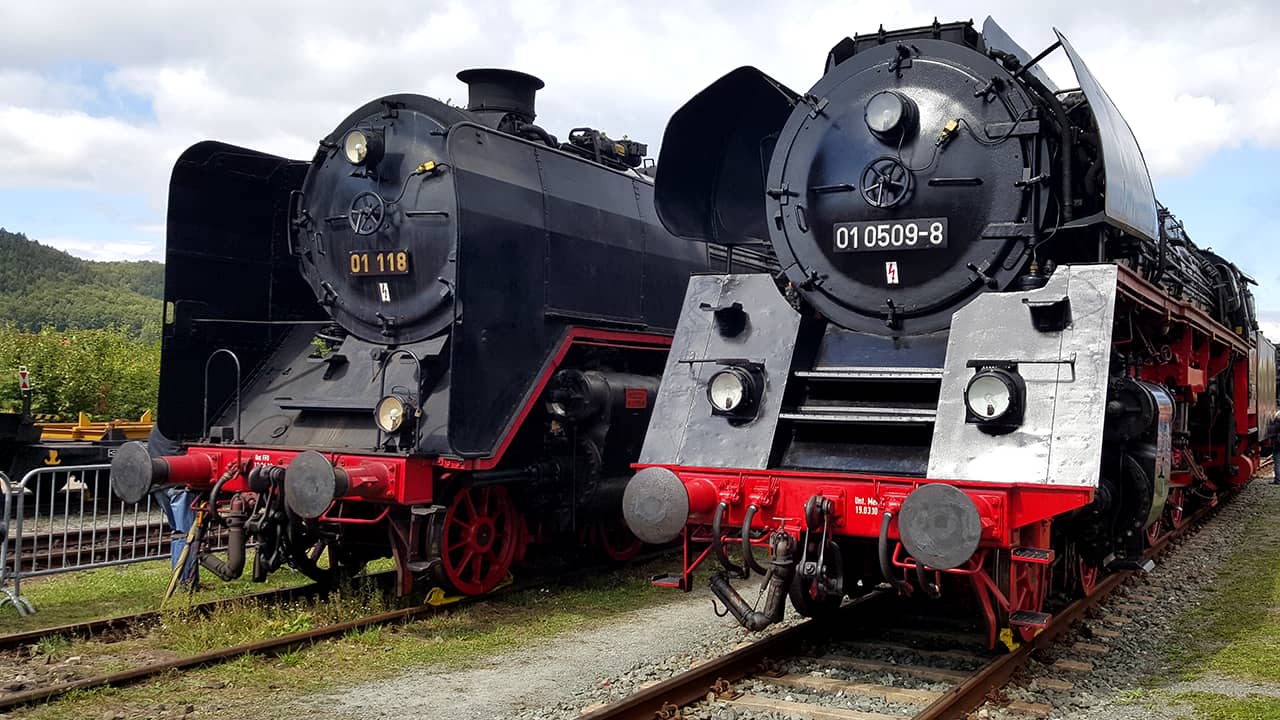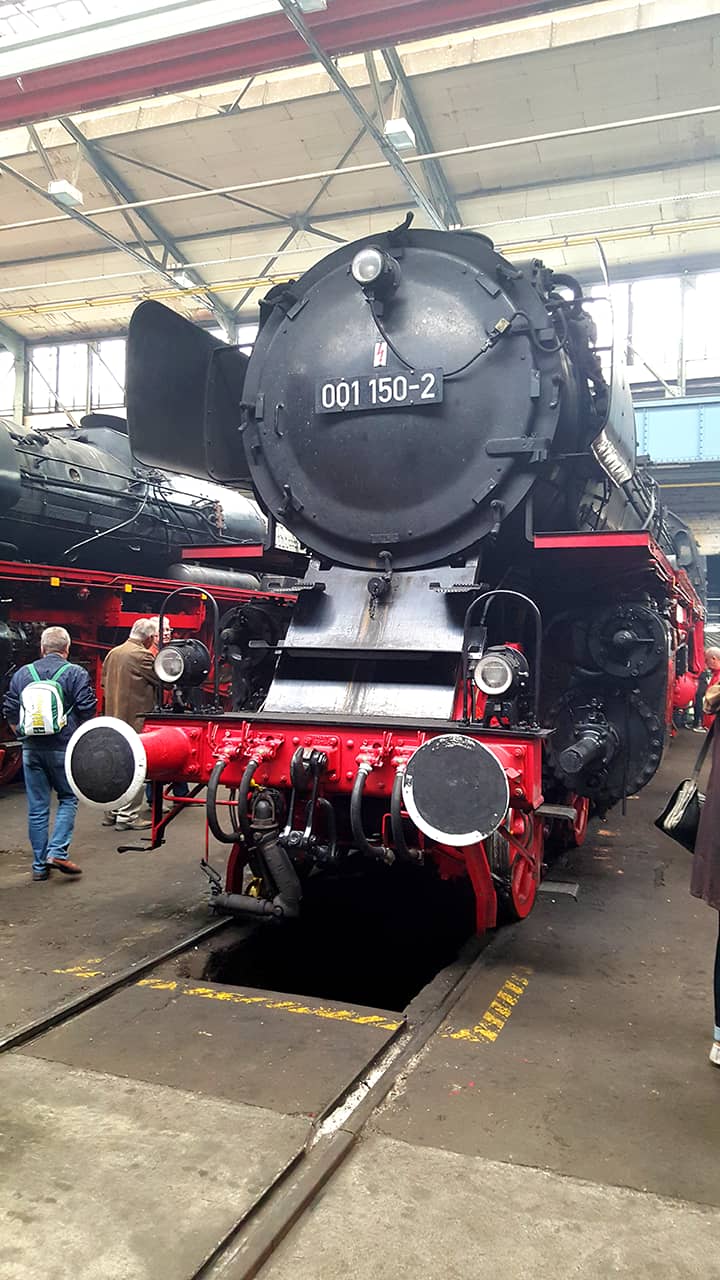DRG Class 01 - the express locomotive of the DRG
The DRG Class 01 steam locomotive is a locomotive with a tender of the Deutsche Reichsbahn. The engines were driven by two cylinders and were used in heavy express train service. The steam locomotives Class 01 are the first unit steam locomotives with the axle arrangement 2’C1′ that were built in series.
Due to the axle arrangement they are also called Pacific. In the 1960s some 01’s were reconstructed by the Deutsche Reichsbahn. As a result of the reconstruction these machines were classified as class 01.5. In the 1930s, based on the two-cylinder engines, the three-cylinder engines of the 01.10 series were developed.
| Manufacturer: | AEG, Borsig, Henschel,BMAG, Hohenzollern,Krupp |
| Length: | 23,940 mm |
| Numbering: | various |
| Weight: | 108.9 t (01 001-101) 111.1 t (from 01 102) |
| Years of construction: | 1925-1938 |
| Top speed: | 120/130km/h forward, 50/80 km/h reverse |
| Retirement: | 1982 |
| Fuel supply: | 10.0t hard coal |
| Water supply: | 30.0/32.0/34.0 m³ |
| Number: | 231 + 10 former series 02 |
| Power: | 1648 kW (2240 hp) |
| Train heating: | Steam |
| Boiler over- pressure: | 16 bar |
| Grade: | S 36 20 |
| Type: | 2'C1' h2 |
| Interesting Facts |
|---|
| The steam locomotive DRG Class 01 belongs to the
2'C 1' h2 or h3 type of construction. It has
2 successive bogies united in one
bogie, independent of the main frame
independent of the main frame, as well as 1
independent of the main frame.
The steam type is superheated steam and the
machines have 2 or 3 cylinders. More interesting facts |
The history of the express steam locomotive DRG Class 01
From 1926 to 1938 a total of 231 units of the standard locomotive were delivered to the Deutsche Reichsbahn. The copies were produced by the main manufacturers AEG and Borsig, as well as by Henschel, Hohenzollern, Krupp and BMAG (formerly Schwartzkopff). The class 01 is the most powerful German locomotive type up to that time, as it has a towing hook power of 1850 PSe at 60 km/h. The DRG Class 01 was on a par with the Bavarian S 3/6 in terms of coal consumption and had a low 1.17 kg/PSe*h.
Before series production was launched, ten machines with two-cylinder engines and ten machines of the sister 02 series with four-cylinder composite engines were built. These were then subjected to extensive measuring and test runs. The final decision was made in favour of the two-cylinder engine, which was easier to maintain. However, they lagged somewhat behind the four-cylinder composite engine in terms of fuel utilization and performance under some operating conditions. Furthermore, the design of the four-cylinder composite engine was flawed.
The first locomotive of the 01 series to be handed over to the operational service was the 01 008, which was preserved in the Bochum-Dahlhausen railway museum. The series delivery of the DRG Class 01 was initially delayed a little. On the one hand, there were not enough lines with the necessary careless axle load of 20 tons in the 1920s, and on the other hand there were no turntables with sufficient diameter available. In the 1930s the DRG Cclass 01 became the dominant express locomotive. In 1938 all 231 locomotives of this series were available. The conversion of the four-cylinder locomotives BR 02 into two-cylinder machines added another ten 01’s (01 011, 01 233 – 241).
The development of a third variant
At the beginning of the 1930s a third variant was developed due to axle load restrictions on many routes. The 03 series with a two-cylinder engine and an axle load of 18t came to 298 units built. From 1939 onwards the Deutsche Reichbahn had the three-cylinder locomotives of the 01.10 series, which was based on the basic series, built. These locomotives had a higher speed and were equipped with a streamlined fairing.
The comparative operation of the 01 and 02 series took place in the Erfurt P, Hamm and Hof depots. In the 1930s the Class 01 operations were concentrated on relatively few routes. Starting in Berlin, the lines included the Anhalter Bahn, the Lehrter Bahn, and the Hamburger Bahn. The Berlin city railway line could only be used with the DRG Cclass 01 after the viaduct arches had been reinforced as a result of a modernisation.
Until 1930, 90 machines were stationed in the depots in Essen, Nuremberg, Erfurt P, Berlin Ahb, Hamm, Magdeburg, Kassel, Hannover, Hamburg-Altona, Bebra and Offenburg. From 1931 Frankfurt (M), Berlin Leb, Braunschweig, Berlin Pog, Schneidemühl, Königsberg, Göttingen P, Paderborn, Dresden Alt, Breslau, Cologne Deutzerfeld, Hof and Halle P followed.
The maximum speed was initially limited to 120 km/h. From the locomotive with the road number 01 102 onwards, the speed was increased to 130 km/h. This was achieved by enlarging the diameter of the front wheels from 850 millimetres to 1000 millimetres and by strengthening the brakes. This was achieved by placing brake blocks on both sides of the coupling wheel sets and braking the towing wheel set. Since the delivery of the 01 series from 01 077 onwards the locomotives have been fitted with Wagner wind deflectors. The air and feed pumps were located in smoke chamber niches behind these guide plates.
On the other locomotives the original smoke deflectors were replaced by Wagner smoke deflectors. However, this made maintenance work more difficult. For this reason, the pumps of later unit locomotive series were placed in the middle of the vehicle ex works. In the case of the German Federal Railways, the locomotives were equipped with smaller Witte smoke deflectors and the pumps were moved to the centre of the vehicle in the circulation plates. The Deutsche Reichsbahn changed the appearance of the locomotives only slightly until the end. Thus the weight distribution was not changed.
Changes from the third series
From the third series (01 077 ff.) the boilers were delivered with extended smoke pipes and a shortened smoke chamber. In addition, all locomotives had a central locking system for the smoke chamber door. The first DRG Class 01 locomotives built were delivered with gas lighting. From 01 010 onwards there was then electric lighting. The third top light was only supplied to the last deliveries.
The 01 locomotive series was delivered with trailing tenders of the type 2’2 T 30, 2’2 T 32 or 2’2 T 34. The fuel supply was 10 t and the water supply 30, 32 or 34 cubic metres. Due to the insufficient number of large turntables, the pre-series locomotives 01 001 to 01 010 were partly delivered with the small tenders 2’2 T 30. The 2’2 T 30 tenders were later only used when necessary, e.g. in border traffic with the Netherlands. The machines of the second series (01 012 ff.) were delivered with the riveted tender 2’2 T 32. During the war years and after the Second World War the welded tenders 2’2 T 34 were used almost exclusively. They only came to the class 01 on the exchange route (often from brand-new locomotives of class 44) and had a larger water supply.
The German Federal Railways used 165 DRG Class 01 locomotives until 1973. The Hof depot in Upper Franconia was the home of the last locomotives from the end of the 1960s. These machines were used on the well-known steep track “Schiefe Ebene”. During the end of the steam locomotive operation with the German Federal Railways these machines reached cult status with many railway enthusiasts. Thus the “Schiefe Ebene” became a place of pilgrimage for photographers and steam locomotive enthusiasts from all over the world. In June 1973, the last eight operational vehicles were taken out of service after numerous farewell rides and a parade in front of the Hofer Lokschuppen.
The class 01 was still in service with the Deuschen Reichsbahn until the early 1980s. The express locomotives were used in front of D-trains on the Berlin-Dresden line until autumn 1977, when the Soviet class 132 large diesel locomotive (Ludmilla) was put into service and the almost 50-year-old express locomotives were gradually taken out of regular service.
A special feature is the approval of the operational locomotives 01 118 and 01 150. They have a higher permissible running speed for journeys with tender ahead. The background to this is that suitable turn-around locomotives by means of turntables or a track triangle by dismantling are now only rarely used. The specimens that have been specially approved due to technical upgrading may travel at 80 instead of 50 km/h in front of passenger trains with the tender in front.
DRG Class 01 - The conversions
In the years 1950 – 1951 5 machines were converted by the German Federal Railways. These included the 01 042, 01 046, 01 112, 01 154 and 01 192. During the conversion work, Henschel mixing preheaters from Heinl and turbo feed pumps were added. Furthermore, combustion chambers were installed in the boilers. To complete the conversion work, the Wagner wind deflectors were replaced by Witte deflectors. Despite their smaller dimensions, the Witte plates were just as effective as the Wagner wind deflectors. Four of the five rebuilt locomotives remained in operation until 1968. The fifth was equipped with a new boiler.
DRG Class 01 - Preserved locomotives
01 066 – The oldest locomotive in service is the 01 066 built by BMAG in 1928, which was in service with the Deutsche Reichsbahn until 1977 (among others as 01 2066-7) and served as a heating locomotive at the VEB Waschmittelwerk Genthin in Nauen until 1989. It was not adapted to the last delivery series and thus retained its small bogie wheels and the original load compensation. The 01 066 was completed at the Meinngen steam locomotive works on behalf of the Bavarian Railway Museum in Nördlingen and was put back into service in the summer of 1993.


